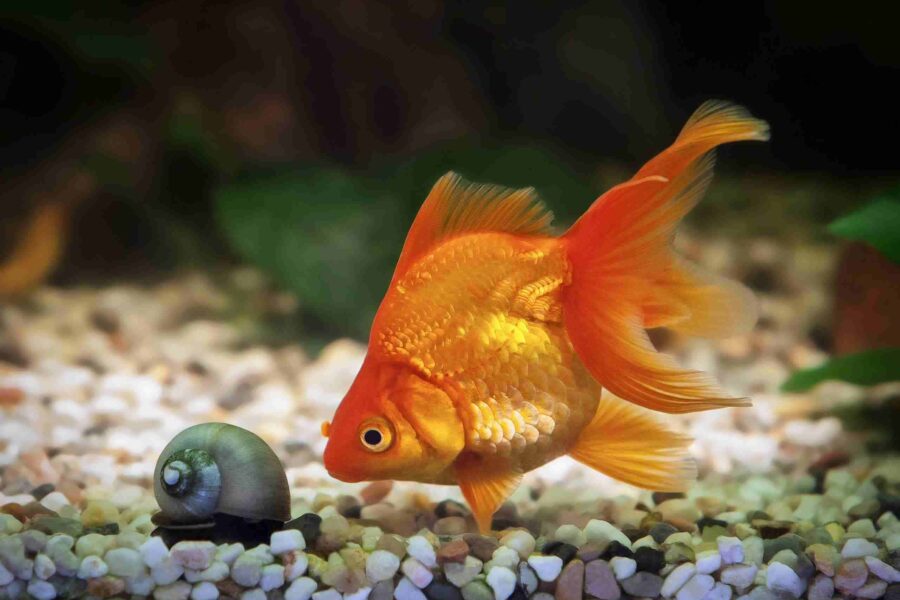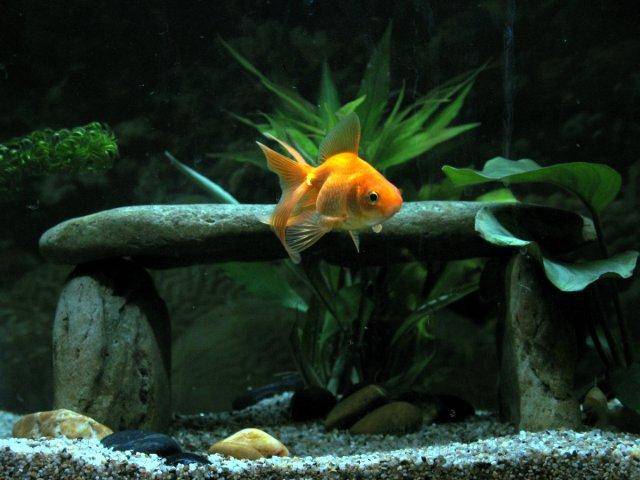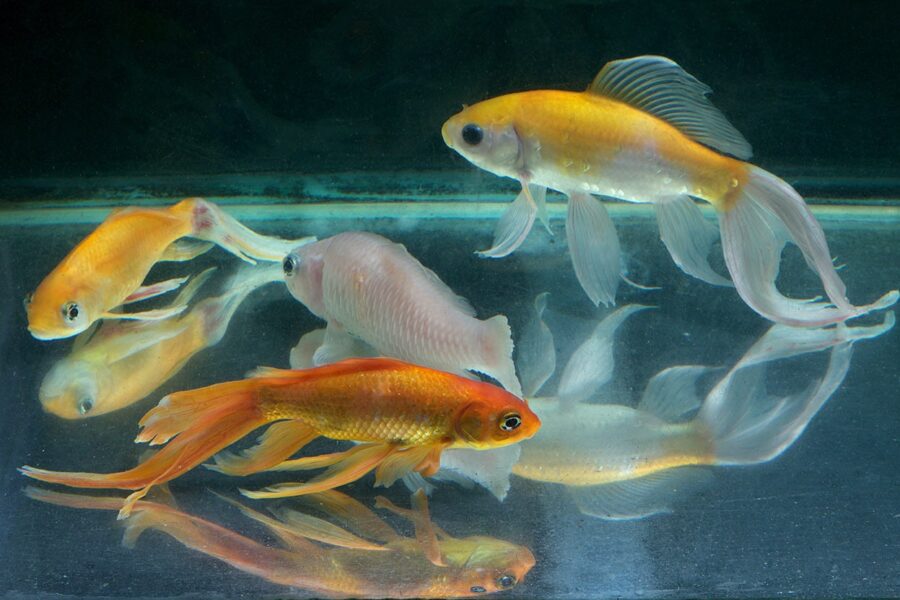
Welcome to the vibrant world beneath the water – the realm of graceful goldfish! Dive with me as we unravel the intriguing nuances of their habitat. Let’s get to know why substrates, all the little gravel and sand decorating their bowl, are more than just pretty home decors in our pet’s living space.
We traverse through gravel terrains, sand dunes, marble seas, and even the barren underwater lands – all possible substrates for your flappy friends. Each has its beauty and ease of maintenance, but how do they fare health-wise for our goldfish? As we swim forward, we’ll also learn how to best select their ideal underwater flooring, balancing aesthetics and functionality, and avoiding unforeseen substrate issues. And of course, who can resist some fun goldfish trivia and interesting substrate facts? Keep swimming!
Goldfish and Their Living Spaces
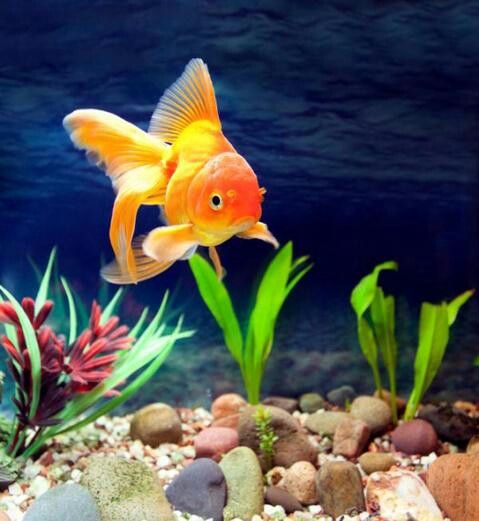
Goldfishes are like underwater divas, they love to live in style underwater. That’s why it’s not just about popping them into a tank full of water. A whole ecosystem needs to be established to keep them happy and healthy. A significant part of this underwater environment is the substrate or the “flooring” of their tank.
Goldfish Ecosystem
Picture this, goldfish are swimming, gobbling up their food, they defecate (yep, they do), they stir the water with their swift movements. You’re picturing an ecosystem, aren’t you? A self-contained world formed in a fish tank. Here’s an inside scoop: goldfish are lovable but a tad messy. Their poop and leftover food can quickly turn into ammonia, which is toxic! And the nifty thing about substrates? They’re a gathering spot for beneficial bacteria that break down these nasties.
Why Substrates Are Necessary
Substrates aren’t just there to make your fish tank Pinterest-worthy. They play an essential part in water filtration and help maintain the water’s chemistry. Substrates also provide your goldfish with an environment that’s similar to their natural habitat. Hence, giving the little swimmers some homey comfort forgetting they are living in a glass box.
Okay, now we’ve surfaced on why substrates are a must-have for goldfish tanks. Next, let’s dive into the types of substrates you can surround your goldfish with to make their environment aesthetically pleasing and healthy.
Your Goldfish’s Downstairs: Types of Substrates

Life under the sea–or in this case, your aquarium–is exciting! But before we dive deep into this aquatic world, let’s lay the groundwork. And by groundwork, we mean the substrate.
Gravel: The Classic Choice
Ever consider pebbles to be pet-friendly? Me neither, until I met a goldfish! Gravel is the OG of aquarium substrates. It’s easy to clean and comes in a range of colors to match your decor. Or mood. Who says your fish doesn’t appreciate color coordination?
If you’re interested in delving deeper into this topic and want the best for your finned friend, check out our article on the 5 Best Gravels for Goldfish Tanks.
Hang in there, we’re just getting our feet wet. Next up, a substrate as timeless as a sandcastle.
Sand: Blending in With the Mermaids
If your goldfish dreams of becoming a mermaid, sand is your go-to. Not only does it look natural, but its fine grains are perfect for those fish that enjoy a bit of light digging. Just be careful not to make your snack-eager goldfish swallow it!
For those wanting the finest sands tailored specifically for goldfish, dive into our article on the 5 Best Sands for Goldfish Tanks.
Believe it or not, we’re still on the shoreline. Try not to get too marbled at our next substrate.
Want your fish tank to resemble a disco ball? Say hello to marbles! Apart from being aesthetically pleasing, they also create lots of hidey-holes for leftover food. Remember, though, an uncaptured dinner means more cleaning. The downside to being too funky, huh?
Don’t worry if none of these options float your boat. Our last category might get along swimmingly with you.
Naked Tanks: Sometimes Less is More
The minimalist in you might just want to leave the tank bare. Trust me, it’s not rude to your goldfish! They can actually live without any substrate. It also makes cleaning a breeze. However, a little sparse on the eye, wouldn’t you agree?
Wow, we’ve covered a lot of ground in the underwater terrain. Remember, there’s no right or wrong choice. You do you, and your goldfish will adorably gurgle along. Ready to compare these options? Because it’s getting deep in here!
How Each Substrate Compares
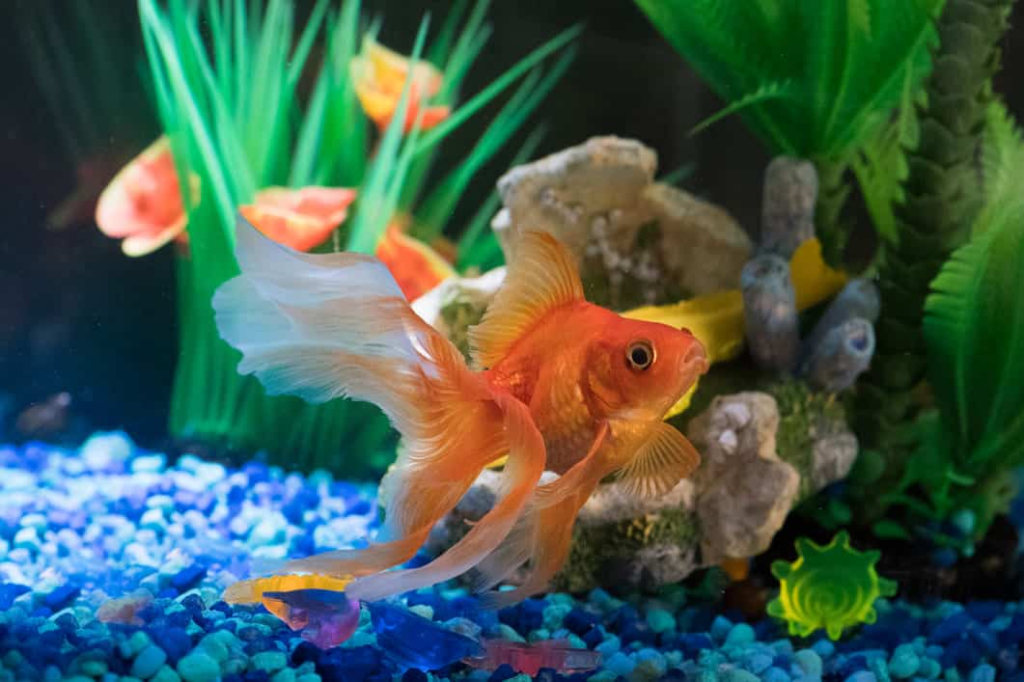
Whoa! Buckle up because we’re going to dive deeper, literally! Let’s compare different substrates based on aesthetics, cleaning, and their effects on your fin-tastic goldfish.
The Eye Candy: Aesthetics
First, let’s address the shallower aspect (no judgment!). A gorgeous goldfish tank is a room’s centerpiece, and the substrate plays a stunning supporting role. Gravel offers a natural, river-like feel, as if your goldfish are floating down the Mississippi. You can snag it in various colors to match any eccentric decor.
Sand offers a beachy vibe, making your goldfish the star of a perpetual marine photoshoot. Marbles, on the other hand, are the divas. They command attention with their flashy sparkle. Having no substrate is the minimalist’s choice, giving your tank a sleek, modern look.
Next, we’re going to talk about the one chore every aquatic pet owner secretly dreads.
Ease of Cleaning
Goldfish are lovely, but let’s be real, they’re messy eaters. That’s where cleaning your substrate comes in. Gravel can be a bit tricky, as debris tends to hide between the stones. Sand might seem like a beach picnic at first, but it’s a hiding paradise for uneaten food and waste.
Marbles? They may shine like a disco ball, but those inter-marble spaces make cleaning feel like finding hidden treasures, minus the ‘treasure’ part. And if you choose to go bare-bottom, you will have easy cleaning days, just be ready for a not-so-picture-perfect view of waste lying around.
But wait, we also need to remember our squishy, water-bound friends.
Health-check Time: Effects on Goldfish Health
Most importantly, you want your golden pals happy and comfortable. Gravel can provide niches for beneficial bacteria, which help keep the water cleaner. Sand, though, may irritate your goldfish’s gills. Marbles can be tricky swimming grounds and aren’t recommended for bottom-dwelling goldfish.
A tank without substrate might seem carefree, but remember, it can stress your goldfish as they need something to forage in.
Now that we’ve compared our substrates, let’s glide over to weigh in your goldfish needs and your aesthetic preferences to make the perfect substrate choice in our next section.
Choosing the Right Substrate for Your Goldfish
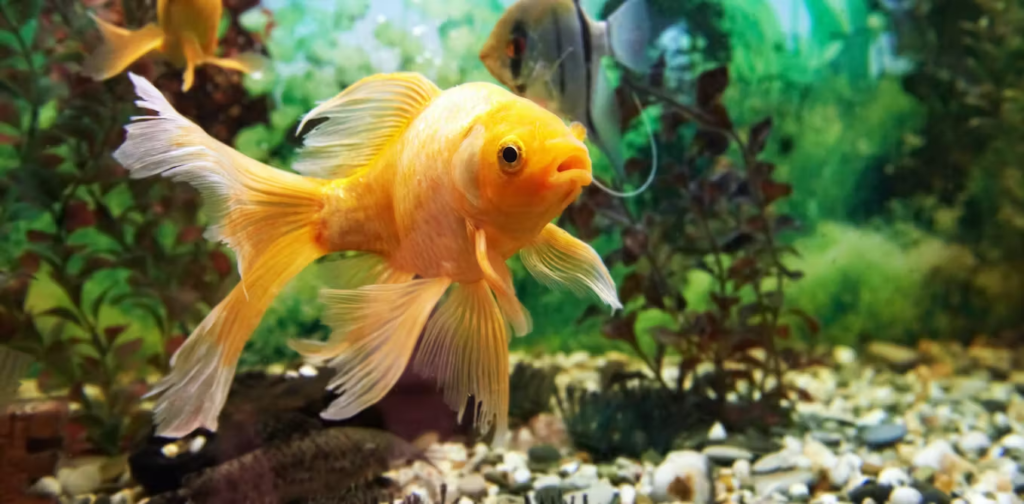
After getting schooled in the world of substrates, one might think, “Well, now, which one suits my bubbly aquatic friend best?” Fear not! The journey of choosing the right substrate begins now.
Substrate Guidelines
Like any decision in life, from choosing between doughnut flavors to electing a new president, there are some guidelines. Prevent the fine grains from choking your finny friends or avoid a Vegas-like scene with marbles at the bottom of the tank. The grains should be larger than two millimeters—size does matter here—and smooth round the edges to keep those Goldie fins safe!
For a comprehensive look at the top substrates suitable for all tank sizes, take a deep dive into our article on the 5 Best Substrates for Goldfish Tanks of All Sizes.
Considering Your Goldfish’s Needs
However, you also need to consider the tastes of your golden pet. Some goldfish play ‘Hide and Seek,’ burying themselves in the substrate, others do a cute thing called “grifting,” where they sift the substrate through their gills. Choose a substrate that propels their peculiar behaviors, because happy goldfish equals a happy tank!
Balancing Aesthetics and Functionality
Finally, there’s the question of making your goldfish tank drop-dead gorgeous. The magic lies in balancing aesthetics with the substrate’s functionality. Remember, your goldfish will care more about how comfortable their feet are rather than the Kardashian-level glamour of their home.
And just when you thought you’ve learned all there is to learn about substrates, let’s head into the murky waters of common substrate problems and the secret ninjutsu tricks to dodge them.
Common Substrate Issues and How to Avoid Them

Did your goldfish pull a face at you this morning? Or maybe you noticed something strange happening underfoot in the tank. Our little aquatic pals shouldn’t have to deal with a subpar substrate. Let’s look at some common substrate issues and dish out our best tips to sidestep them.
Dirty Substrate
First on our list, the dirty substrate. A murky bottom is no place for a star. It’s like hosting a pool party in mud! Yet, getting the substrate polished and sparkly can be as slippery as a fish.
Remember to clean the tank and substrate regularly. Use a siphon to suck out the dirt. Be gentle, though! We don’t want to take out the good stuff. Your substrate should never be dirtier than a bachelor’s apartment. It’s not pretty, trust me.
Substrates That Impact Water Chemistry
Switch on your chemistry brain for a second here, folks. Substrates like coral can adjust your water’s pH. Maybe you like surprises. Maybe your goldfish likes his morning coffee alkaline. But frequent pH swings? We ought to avoid those.
Choose substrates that won’t mess with your water pH. No one likes a layered latte when they asked for black coffee. Well, your goldfish doesn’t either. Do research or ask an expert to prevent you from turning your tank into a science experiment.
This covers the common issues and fixes for those pesky substrate woes. However, this doesn’t prepare you for the random trivia blitz at your next office party, right? And there’s always that one annoying guy who seems to know everything. So, coming up next, let’s endow you with some entertaining little nuggets about goldfish and substrates. Get ready to impress!
Fun Facts About Goldfish and Substrates

We’ve covered lots of serious stuff about goldfish and their substrates. Now let’s loosen up a bit with some fun trivia! Dive in, and learn a thing or two!
Goldfish Related Trivia
First off, did you know that goldfish have a memory span of three months, not three seconds like the legends say? Yes, fish can remember! They can learn and remember tricks, which might beg the question: Can they appreciate their substrate? Food for thought! And speaking of food, be sure to explore our article on Discover the Best Foods for Your Goldfish for a nutritious dive.
Next, let’s talk size. Common goldfish can grow up to 18 inches long! Imagine that fish in a tiny bowl. Thinking about substrate choice in relation to tank size makes a lot more sense now, doesn’t it? For those eager to find the perfect habitat for these finned wonders, take a look at our roundup of the 10 Best Goldfish Tanks on the Market.
Interesting Substrate Facts
Moving on to substrates, bet you never would have guessed that sand can actually support good bacteria, aiding in your goldfish’s health. Isn’t that interesting? If you’re curious to know more about this, dive into our article Sand for Goldfish: Is It Good or Bad?.
And about marbles, these shiny round things create delightful visual effects. They can create an amazing, vibrant world underneath the water for your goldfish to enjoy and for your guests to marvel at.
We have arrived at the end of our fun facts section. Hope you enjoyed these tidbits of trivia! In our next, and final section, we’ll be summarizing all we’ve discussed, just to make sure we’ve got a grasp of how goldfish tanks rock with the right substrate. Let’s move to the conclusion!
Wrap Up
In summary, the substrates you choose for your goldfish’s living space truly make a difference. Whether it’s gravel, sand, marbles, or no substrate at all, each brings its own aesthetic appeal and ease of cleaning. However, these should never overshadow the impact on your goldfish’s health. It’s crucial to balance aesthetic appeal with functionality, always keeping in mind the needs of your finned friend.
Avoid common issues around dirty or chemically-impacting substrates. Cleaning regularly and selecting carefully can prevent these problems. Also, don’t forget to appreciate the fun side of things. From interesting substrate facts to amusing goldfish trivia, there’s always something new to learn in the underwater world of goldfish keeping. Keep these guidelines in mind, and you’ll ensure a happy, healthy habitat for your pet.
Frequently Asked Questions (FAQ)
Question: Why are substrates necessary for a goldfish tank?
Answer: Substrates help in the biological filtration process, provide living spaces for beneficial bacteria, and give goldfish natural boundaries and an environment similar to their natural habitat.
Question: What are some types of substrates I can use in a goldfish tank?
Answer: You have options like gravel, sand, marbles or even no substrate at all. Every type has its own pros and cons.
Question: How do I choose the right substrate for my goldfish?
Answer: The choice depends on several factors, like your goldfish’s breed and size, the type of tank, your aesthetic preferences, and how much time you can dedicate to cleaning and maintenance.
Question: How does a substrate affect the water quality?
Answer: Some substrates can influence water chemistry, for example, by altering its pH-levels. It’s essential to choose a substrate that doesn’t harm your goldfish’s health.
Question: How often should I clean my goldfish tank substrate?
Answer: Regular tank cleaning is important for your goldfish’s health. It depends on the type of substrate, but generally, a weekly cleaning or at least twice a month is recommended.
Question: Are there any substrates goldfish particularly enjoy?
Answer: Goldfish tend to enjoy substrates they can sift through, such as sand or fine gravel. However, it heavily depends on the individual goldfish’s behavior and preferences. Always observe your fish’s interaction with the substrate.
Question: Can I mix different types of substrates in my goldfish tank?
Answer: Yes, you can mix different substrates, but be careful as some combinations might make cleaning difficult, or could potentially affect the water quality or your goldfish’s behavior.

